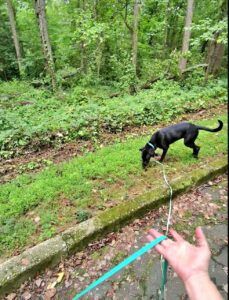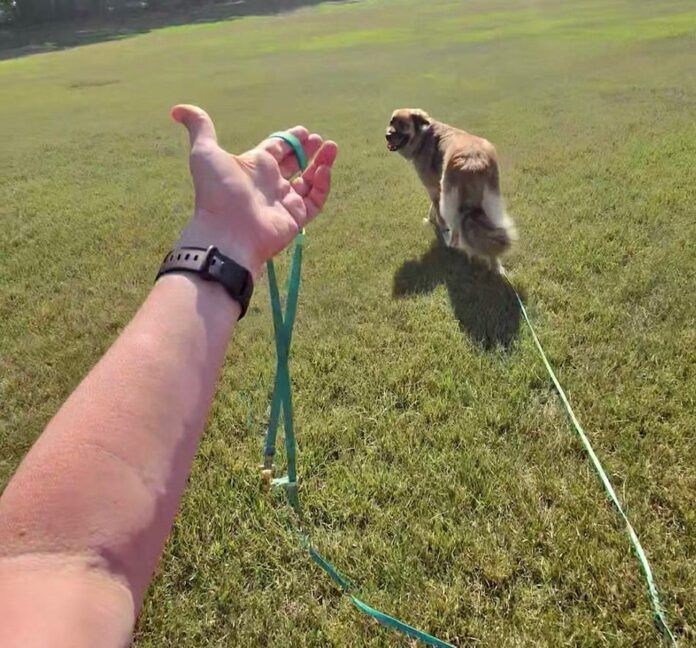There are lots of tools out there designed to solve your dog problems, but you know what might be your best bet? A no-frills, inexpensive, 20-foot lead.
This least sexy of all tools addresses the three most common frustrations we trainers hear about from dog owners: leash-pulling, reactivity, and a refusal to come when called. The trick, of course, is learning how to use that extra length to teach the good stuff.
Learning Not to Pull
The ever-changing outdoor environment is wildly exciting for our dogs. Alas, when they enthusiastically zigzag after every scent, bike, or friend, they yank us along with them. Caught without a plan, we end up pulling right back. Very quickly, a pattern becomes ingrained: walks consist of a constantly taut leash, and conflict.
To break free, start fresh! Head to a new spot, with a different approach. Ditch the 6-footer and grab a long line, which is essentially a longer, thinner, lighter leash. This beautifully simple device can allow you and your dog the graceful distance to begin learning how to move through the world together in sync, without constant two-way tugging. (I don’t use retractables for many reasons, including the fact that it teaches a dog that constant leash pressure is normal.)

Give it a try. Take a 20-foot lead, grab a pouch full of terrific treats, and head to a big park at a time that’s not too busy so that you’ve got some room. As soon as you get out of the car, reward your dog for some things that are easy for her to do even amid distraction. (It’s okay if that’s just “find it” as you keep tossing a treat right in front of her!) Now she knows you have the stuff she loves best— dried liver? tiny bits of cheddar?—on board.
Next, let your dog follow her nose, perhaps encouraging her to the edges of the wilder-looking areas where animal smells will naturally slow her down. The beautiful thing here is that she can enjoy her sniffari—scenting back and forth, leaping forward, then lingering—without pulling that very long leash taut. If you tried to do this with a six-footer you might already be in conflict, and annoyed.
Now, here’s the big moment that will be the cornerstone of your future loose-leash walks around the block: After at first being too absorbed in her surroundings to check in with you, your dog is finally going to look in your direction. The very second she does, reward her! Give a happy “yes!” and a taste of the very best you have, maybe the salmon-flavored Bark Pouch.
It is so very easy to miss this incredible moment! Don’t. Train yourself to watch for and reward every single voluntary check-in: the head swivel in your direction, the quick moment of eye contact, the move closer to you, the circle back to hang next to you. Remember, you’re not asking for or cueing this engagement, you’re waiting for her to offer it. That’s the dynamic we want to set up for the future! We don’t want you to have to constantly ask for her to move with you through the world—we want her to choose it. This simple, beautiful activity teaches just that.
Once you’ve been rewarding simple check-ins for a while, and she’s choosing to hang out near you, the next stage is to offer an easy “find it” as you walk along. Is she sticking with you even though she’s got 20 feet of freedom? Now you know she’s in a perfect state to learn that it feels great to engage with you on leash. You can start asking for whatever she does easily at home—maybe that’s just sits and touches, or maybe it’s downs and stays. Maybe you’re going fast, slow, fast, slow, encouraging her as she matches your pace. At this early stage, there are treats galore as you work to instill a deep sense that hanging close to you is the most rewarding choice no matter the environment. That understanding is the prize, and it’s what will eventually allow you and your dog ready to walk in sync on a 6-foot leash around your own block.
Build a Great Recall
A long line is also an incredible tool for teaching a terrific recall. Perhaps your dog is happy enough to come when you call him at home, but the second you’re anyplace more interesting—forget it! That’s a typical stage in recall training, and many people stall out there.
Enter the long line. Start with exactly the scenario outlined in the previous section: 20-footer, great treats, big park, and a sniffari. Wait for those voluntary check-ins, and reward a few. Now we’re ready to teach a great recall.

Here’s the crazy-sounding key to training your dog to respond to the cue “Come!”: Don’t call him until he is already coming to you! If, in the beginning stages of training, you call him when he’s completely engaged in a scent, or staring at a bird, the odds are low that he’ll respond. If you do that over and over, the word “come” will become background noise that is, if anything, just annoying. Instead, wait for an obvious win for you both. When he finishes sniffing a particular plant, turns to you and begins to meander over, cheerily start calling him, and then reward with something terrific.
Here’s the important next step: then encourage him to go off and have more fun. So often, dogs don’t hear “come” until the end of the adventure, right before they have to get in the car and go home. An enormous part of successful recall training is making sure that negative link does not get established. Right after you reward that “come,” follow up with “Let’s go sniff some more!”
Then . . . repeat, and repeat. Spend a lovely hour at the park, marking and rewarding engagement, calling your dog as she is already coming. Now it’s going to be really sinking in that engaging with you is like winning the jackpot.
If you’re like the rest of us, you’ll now be tempted to push it. You see your dog at the end of the long line, staring at another dog across the park, and you want to call her, just to see if it worked and you now have a great recall. I know it’s tough to resist, but I promise that the tortoise really does win the race. Don’t call a dog who is having a great time doing something else until way, way down the line in your training. Great dog training is like watching paint dry, folks. It’s really boring—but then at some point the result is actually beautiful.
You can definitely build on your recall training by doing all of this off leash in your own yard, but the benefit of the long line is that it mimics the situations where you’re really going to want that recall. If your dog is used to being pretty far from you in an interesting new place and still coming when called, that’s a big win.
Decreasing Reactivity through Observation
One of the things I most like “prescribing” to a client who’s upset about her dog’s reactivity is to go hang out in a park with a long line. It’s easy, it’s relaxing, and it helps—sometimes dramatically.
It’s jarring when your dog who’s so sweet at home turns into Cujo on a walk, barking and lunging at dogs, people, cars, bikes, or whatever else. It’s easy to interpret that response as angry aggression. But very often it’s fear, based on lack of familiarity: “I don’t know what the heck that is but it’s probably a threat and I’d better make sure it doesn’t get closer!”
It’s time for—I know you know the answer by now, so say it with me—a long line and a big park! Why? Because our dogs can’t read books or browse the internet. The only parts of the world they can learn about are the teeny tiny slivers we show them. So of course many dogs are anxious and bark out their big feelings when they head outside of their home cocoons and see new things that are fast, loud, looming and unpredictable.
Dogs need to gather data to feel better about their world, and a long line in a park is a terrific, safe-feeling way to do that. Distance is the worried dog’s best friend, and he needs you to arrange it for him. Ponder the best spot and the best time. Get out of the car only after making sure the coast is clear. Maybe that sounds like a lot of work, but surprises are the enemy of feeling safe. Just because you know that little barking leashed chihuahua isn’t a threat doesn’t mean your dog knows that!
Here’s how we teach him. Let him first catch sight of that chihuahua from a long distance. Let him watch. Let him process what he sees, hears, smells. If he’s barking or lunging, he needs more distance. Back up until he can observe calmly. Then just sit together and gather data. (You don’t need a long line to do this part, but it can help establish a sense of his having agency during this experience.)
After a while, your dog will realize that the Chihuahua is not a threat and turn to you. That’s a huge moment. He’s just come to a conclusion: “Hey, that thing over there is no big deal. It won’t affect us.” Offer a treat. Offer some easy cues (sit, touch). If he’s stealing glances at the chihuahua and then back to you, he might need a bit more time to observe. If not, he’s ready to move on until there’s something else he needs to learn about. Kids playing basketball? A group of folks on a picnic? Another dog playing frisbee? Get yourself to a distance that feels safe to your dog and let him watch until he doesn’t need to anymore.
A lot of the very best dog training looks like doing nothing! If I made a video of one of these sessions, it would seem like not much is happening.
Untrue. An enormous shift is occurring. A dog is beginning to feel safe in his world. Let’s give him the distance and time he needs to fully absorb that lesson.
Long live the long line.







I love my 10-ft long line. We use it for our daily walks. Cash has the freedom to sniff and I have the ability to reel him in if I need to
but how do you deliver the treat when the dog checks in with you on the longline – how close does your dog have to be etc – trying to visualize dog checking in, saying yes, delivering treat without getting dog close to you through some behavior that would still be rewarding for a voluntary behavior